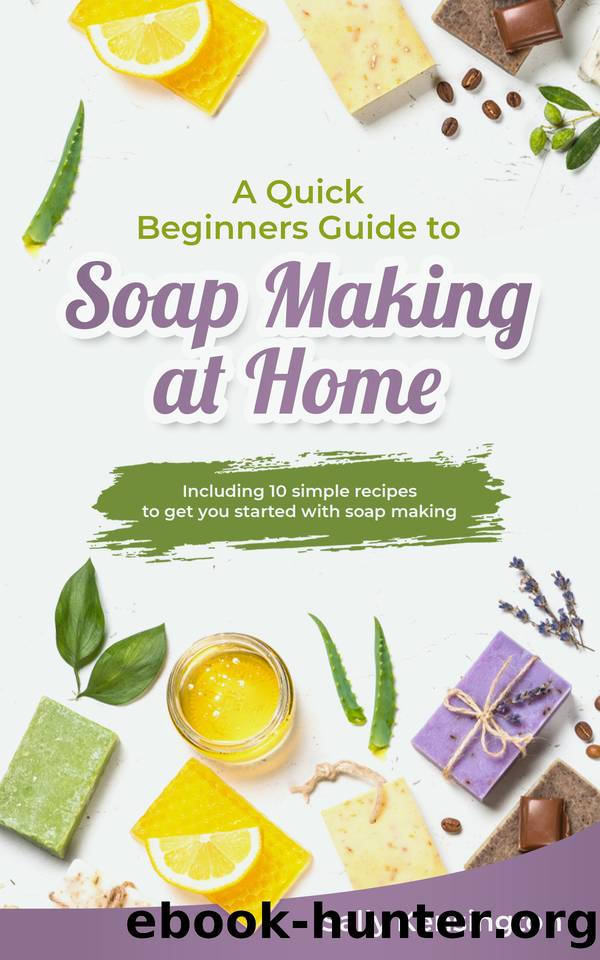A Quick Beginners Guide to Soap Making at Home: Including 10 simple recipes to get you started with soap making by Sally Kensington

Author:Sally Kensington [Kensington, Sally]
Language: eng
Format: azw3, epub
Published: 2020-10-01T00:00:00+00:00
Chapter 8: Step-by-Step Instructions on Cold Press Soap Making
I am sure that by now, you are familiar with the different aspects of soap-making and the elements that go into the process. If you are looking to make the perfect soap that is compatible with your skin type in every way possible, the cold-press method of making soap is a good way to go.
Cold process soap is made by mixing different oils and lye (sodium hydroxide). This initiates the chemical process of saponification, which bonds the different ingredients together and gives you a bar of soap as the final product.
Here are the six steps to the cold-press soap-making method:
Step 1: Weigh the specified amount of lye in a plastic heat-proof container. In a separate container, weigh the water. If you want to be even more accurate, you can use a lye calculator; a lye calculator provides the exact amount of lye and water that you need for a recipe by just entering the oil weight or percentage.
Step 2: Carefully pour the lye into the water and stir gently with a heatproof utensil until the lye has completely dissolved in the water. Set the solution aside and let it cool down.
Step 3: While the lye solution is set aside and cooling down, weigh the butter and oils that you want in your soap. Melt the butter with a double boiler until the temperature comes up to 100 â.
Step 4: After the lye solution has cooled down, pour it into the container of oils. Stir the contents until trace is reached, and there are no streaks of oil in the solution (Trace refers to the point where the oils and lye solution have emulsified together). At this stage, the soap will have the consistency of the batter.
Step 5: Add any extra additives that you want, such as natural exfoliants, colorants, and aroma essences. Stir the contents to make sure that it is thoroughly mixed.
Step 6: After the contents have been thoroughly mixed, pour the melted soap into the soap molds. At this stage, the soap is still caustic, so make sure that you wear protective gear while handling the mixture. Cover the mold with cellophane or paper so that your soap mixture does not get contaminated by dirt and other impurities. You can also wrap the container with a towel to retain heat.
Set them aside for up to 2 days until the mixture has completely cooled down and solidified. Once the mixture has solidified completely, remove the handmade soap from the soap mold and slice it into smaller bars. Make sure that you allow the soap to cure in the open air for at least four weeks before you use it.
Download
A Quick Beginners Guide to Soap Making at Home: Including 10 simple recipes to get you started with soap making by Sally Kensington.epub
This site does not store any files on its server. We only index and link to content provided by other sites. Please contact the content providers to delete copyright contents if any and email us, we'll remove relevant links or contents immediately.
On Writing A Memoir of the Craft by Stephen King(4800)
The Doodle Revolution by Sunni Brown(4598)
A Simplified Life by Emily Ley(4048)
Marijuana Grower's Handbook by Ed Rosenthal(3573)
Mummy Knew by Lisa James(3573)
Better Homes and Gardens New Cookbook by Better Homes & Gardens(3472)
Paper Parties by Erin Hung(3338)
Figure Drawing for Artists by Steve Huston(3334)
Draw Your Day by Samantha Dion Baker(3208)
The Genius of Japanese Carpentry by Azby Brown(3171)
Japanese Design by Patricia J. Graham(3066)
The Code Book by Simon Singh(2998)
Dangerous Girls by Haas Abigail(2914)
Lions and Lace by Meagan Mckinney(2876)
The Curated Closet by Anuschka Rees(2865)
How to Make Your Own Soap by Sally Hornsey(2779)
The Checklist Manifesto by Atul Gawande(2716)
The Wardrobe Wakeup by Lois Joy Johnson(2684)
Zero to Make by David Lang(2669)
